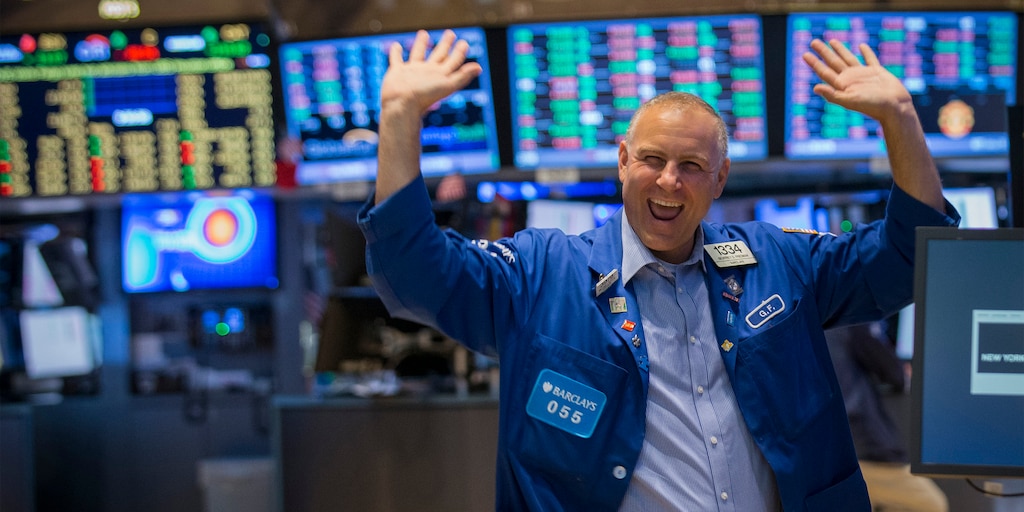 Reuters / Brendan McDermid
Reuters / Brendan McDermid
- Markets were a sea of green Friday as investors backed authorities’ efforts to mitigate the economic fallout from the coronavirus pandemic.
- The Federal Reserve set up temporary access to billions of dollars to nine central banks hit by greenback shortages.
- Senate Republicans unveiled a $1 trillion stimulus plan consisting of direct payments to American households, $200 billion in loans to struggling industries, and $300 billion in bridge loans to small businesses.
- The moves followed similar efforts by the European Central Bank, the Bank of England, and other central banks this week to shore up their economies.
- Visit Business Insider’s homepage for more stories.
Stocks rose, oil jumped, and bitcoin rocketed Friday as the efforts of central banks and governments to fight the novel coronavirus assuaged investors’ fears of global economic disaster.
The Federal Reserve pledged to temporarily provide billions of dollars at negligible cost to nine central banks suffering from greenback shortages, including in South Korea, Singapore, and Australia. It previously reserved those currency swap lines for five key central banks.
Senate Republicans unveiled a $1 trillion stimulus proposal on Thursday. The sweeping plan consists of direct payments to American households, $200 billion in loans to airlines and other distressed industries, and $300 billion in bridge loans to small businesses to help cover salaries, medical benefits, and other key costs.
The US moves came after the European Central Bank, the Bank of England, and other central banks announced sweeping stimulus measures this week. Similarly, the Chinese government plans to back infrastructure investments with nearly $400 billion worth of local government special bonds, Reuters reported.
The novel coronavirus — which causes a flu-like disease called COVID-19 — has sickened close to 250,000 people, killed more than 10,000, and spread to upward of 150 countries. Recent developments include California’s governor issuing a “stay at home” order to reduce transmission as confirmed cases in the US topped 14,000. Italy has surpassed China in total deaths.
Here’s the market roundup as of 10:12 a.m. in London (6:12 a.m. in New York):
- European equities rebounded, with Germany’s DAX up 5.8%, Britain’s FTSE 100 up 3.9%, and the Euro Stoxx 50 up 5.9%.
- Asian indexes rose, with China’s Shanghai Composite up 1.6%, Hong Kong’s Hang Seng up 5.1%, and South Korea’s KOSPI up 7.4%. Japan’s Nikkei slid 1%.
- US stocks were set to rally. Futures underlying the Dow Jones Industrial Average, the S&P 500, and the Nasdaq were up by 4.3% to 4.9%.
- Oil prices jumped, with West Texas Intermediate up 8.7% at $28.20 a barrel and Brent crude up 7.2% at $30.50.
- The benchmark 10-year Treasury yield fell below 1.04%.
- Gold rose 2% to $1,509.
- Bitcoin rocketed 20% to over $6,700.
‘Big questions’
Analysts cheered the raft of monetary and fiscal measures this week.
“Central banks are on their A game and they have learned their lesson from the financial crisis,” Naeem Aslam, the chief market analyst at AvaTrade, said in a morning note.
“Policymakers around the globe are continuously assuring us of more support and this has made investors optimistic about the current rebound,” he continued.
Other commentators, however, warned that markets weren’t out of the woods yet.
“We need to see a further decline in volatility and price stabilization before crying victory,” Ipek Ozkardeskaya, a senior analyst at Swissquote Bank, said in a morning note.
Distributing billions to businesses and households poses a practical challenge, others added.
“Governments are promising big things but there are big questions about how the whole thing can work,” said Jasper Lawler, the head of research at London Capital Group.
“It’s a tough ask to get workers and businesses the cash they need to stay afloat in time.”













